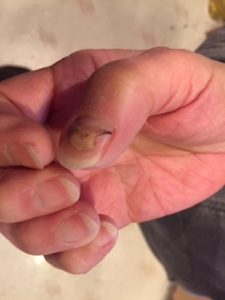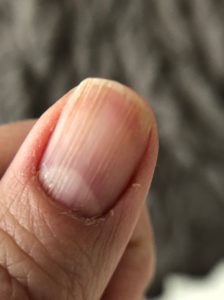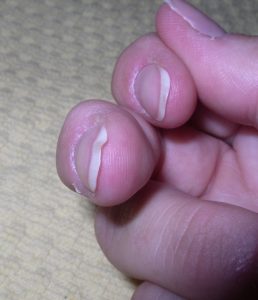During a phone consultation, this is another one of those areas where you need to tell me what is going on. I’ll tell you what to look for and you tell me what you see. We can then work out the core cause together.
A good practitioner of this art can look at a patient’s nails, tongue, eyes, skin and even (if they are really good) shoe wear and the pattern of moles and freckles and be able to tell which organs are weak and which are healthy. Since the nails are the last to receive oxygen because they are the farthest from the heart, they are often the first to show signs of disease processes.
Each finger reflects what is going on in specific organs. Let’s start there:
Table of Contents
Fingernail Analysis–What to Look For
-
The Thumb: Reflects what is going on in the brain, excretory system and in the reproductive organs.
- Index Finger: Reflects what is going on in liver, gall bladder or nervous system.
- Middle Finger: Reflects what is going on in the heart and circulation.
- Ring Fingers: Reflects what is going on in the reproductive organs and the hormonal system.
- And the Little Finger: Reflects what is going on in the digestive system.
I look for certain things when I read a set of fingernails. Let’s address them one at a time and I’ll tell you what I see most often and some possible causes (we call them “rule-outs” in the medical profession). In general, I look for abnormalities in the lunulae, color, texture and markings, shape, and pliability.
Fingernail Analysis–Nail Fungus

Example of nail fungus on the thumbnail. Other fingernails have red lines at the tips. These are called Liver Lines.
Sometimes I miss this, as it is commonly in the toe nails and I’m looking at the fingernails. The safest, cheapest and most effective treatment for this is to apply Vick’s Vapo Rub once a day on the entire nail. Do this every day until the entire nail grows out. Usually this takes from 2 1/2 to 3 months. Clip the nail and keep it as short as possible during this process. Don’t forget to sanitize your nail clippers after you clip those affected nails! The Vick’s has a high concentration of camphor in it which penetrates the nail and oxygenates the area. Fungus can’t live with that extra oxygen.
Many times nail fungus is a sign that the person has a deep-seated yeast infection and has had this for years.
Yeast is also suspected when the cuticles look reddish or have hang nails or people pick at them. But it can also be that they have their hands in chemicals or agents that dry out the cuticles so a good history is necessary when looking at the nails and anything else really. The story has to make sense and add up leading you in a treatment direction.
If that is the case, you will want to review the yeast handout. One product I use often is Myrrh gum powder capsules for yeast infections. It’s one of those herbs that works for the greater portion of the population. You will need to have the dose figured out for you (usually 1-3 capsules/day) and you should take it for several months to kill the yeast from the inside out. This way the nail fungus will be gone permanently. It’s also helpful to eat some raw probiotic foods every day as well. See my recipe section for some of those but raw ferments are all the rage these days for good reason.
Myrrh is not a good choice for children, but it’s the most common yeast treatment that comes up for adults in my practice and does a pretty good job for dogs too.
Fingernail Analysis–The Lunulae
(Lunula is singular form, Lunulae is plural. The lunulae are those little white moon things at the base of the nail): There should be 8 of these. The lunulae on the little fingers should be missing according to Eastern Medicine Philosophy. The one on the thumb nail should be 25% or less than the total length of the nail from base to flesh line at the top.
If the thumb lunula is too large the heart and circulation is working overtime and eventually this overworks the heart. The person may be exhibiting high blood pressure. Other signs that the heart is working overtime would be the presence of “heart line” on the ear lobe (a line just above the lobe itself) and a pointed tongue. If the tongue is red at the tip, there is a more serious involvement of the heart. Working with clients who have this indicator is quite rewarding because the line on the ear lobe can actually resolve. Quite amazing.
Lunulae on the little fingers also is a sign that the circulation is working overtime (especially in the digestive area). High blood pressure may be the cause as well.
Fewer than 8 lunulae: Many rule-outs here such as poor circulation, anemia, fatigue, not enough oxygenation or exercise, heart disease, imbalanced nervous system, numbness, protein deficiency, Vitamin A deficiency or weak-spirited (low life force or “chi”). The most common cause I see is that people forget to breathe and forget to take deep breaths. Check out my Breathing and Meditation handout and practice some meditation.
Lunulae are red or blue or there is a reddish or bluish tinge just above the lunulae but not on the rest of the nail: Heart disease, heavy metal poisoning or lung disease.
Shoot-like things emanating from the border of the lunulae: This is not such a good sign. It can mean thyroid problems or cancer. I have seen many men with this on their thumbnails and most have told me that they had prostate cancer or had their prostate removed due to cancer. I have also seen this reverse when you get to the core cause of this pesky disease in the body, but it takes dedication to do it.
If you have this sign you might want to get a couple of blood tests from your doctor, a PSA (Prostate Specific Antigen) test and a Thyroid panel. It’s always nice to know what is going on so you can do something about it.
An interesting note: You can tell often if a person is right-handed or left handed because the lunulae will be larger (or there may be more of them) on the hand that is used more often.
Fingernail Analysis–Nail Color:
(Now, if you are a hypochondriac, you should probably just skip this part of the website!)
Nail color can be grouped into black, blue, brown/copper, green, blue-green, gray, yellow, pale, purple or red groups. Each color means something different and there are many rule-outs for each color.
Look for the color in general. Nails should be pink. When pressing down on the nail, the circulation should return within one second. This is called Capillary Refill Time. If you know you have traumatized a nail and it is black, blue or various shades of bruise, this is not really anything to be concerned about. The concern comes when some of the nails look different from the normal color. Also match the finger with the organs of the body (see top “What to Look For”) and try to tie in or rule-out other symptoms you may have to what you see.
Here’s a rundown of the colors (this can be subjective):
Black: Anemia, B-12 deficiency, bacterial infection, chronic kidney disease, adrenal gland problems, liver disease, cancer or melanomas, silver deposits (heavy metals), trauma.
Blue: Atherosclerosis, blood is too thick, liver disease, COPD (lung disease), copper or silver poisoning, decreased hemoglobin, drug reactions, gas poisoning, heart disease, hepatitis, high platelet counts, increased cholesterol, inflammation, kidneys with clogged arteries, lupus, prior strokes, rheumatoid arthritis, blood clots.
Green: Allergies to cleaning agents, Bacillus infection, localized fungal infection, serious emphysema.
Brown or Copper: Arsenic or copper poisoning, fungal infections. Note for fungal infections this is a sign that you have yeast inside your body, but you can heal the nail with daily applications of Vick’s Vapo Rub. Continue the daily treatment until the nail grows totally out. Clip the nail short until it grows out completely. This usually takes 2-3 months.
Grey: Arthritis, edema, malnutrition, post-operative effects, glaucoma, lung problems, emphysema, cardio-pulmonary disease.
Yellow: Bleeding, diabetes, digestive problems, liver disease, hyperthyroidism, too much carrot juice, lymphatic problems, nail fungus, poor circulation, respiratory problems, Vitamin E deficiency, fluid retention in the lymphatic system.
Pale or white: Anemia, Candida (yeast), low life force, overall mineral deficiency, heart or lung problems, hemorrhage, hookworm infestation, kidney disease, liver disease, malnutrition, ulcers.
Purple: Oxygen deprivation, circulatory problems, congenital problems.
Red: Brain hemorrhage, heart disease, high blood pressure, lung disease, stroke, carbon monoxide poisoning.
Eek! Are you still with us? Now we’re going to look at nail texture.
Fingernail Analysis–Nail Texture and Markings
The most common markings I see are: Vertical ridges and split nails, horizontal dips, red bands at the tips, yellow tips and white spots, so I’ll just address those.
Vertical Ridges and Split Nails: Lots of rule-outs here, but they include–Adrenal gland problems, arthritic tendencies, asthma, broken heart, bronchitis, calcium deficiency, chronic fatigue, chronic inflammation, chronic stress, depression, emotional trauma, excretory system conditions, hyperactivity or overexertion, iron deficiency, kidney problems, laryngitis, nervous problems, poor digestion/absorption in the small intestine, chemicals from food, dieting, protein deficiency, respiratory problems, unhappiness, Vitamin A deficiency, yeast and other fungi, lupus, chemo or radiation side effect, drugs or prescription use.

This nail is in challenged shape. It has vertical ridges, liver line, the cuticle is damaged because of yeast overgrowth in the gut and they are splitting/peeling.
Remember to look to see if there are ridges on more than one finger and if the ridges are on the same finger of each hand, then go to the top of the page and see which organs are associated with the ridges. That will help in ruling in or out what the cause is. Personally, I just muscle-test it out to see which issues to address and use this as a piece of the entire puzzle.
If you have ridges on all your nails, your intestines are not effectively assimilating the foods you are eating. For these cases, I get them on the ionic or colloidal minerals right away. We need all the help we can get for that and these are the best, most easily digested vitamins and minerals on the market. It would be best to do a systematic cleanse over a period of several months as well.
Horizontal Dips: Poor circulation, picking at the nail bed, heart disease, stress, lack of essential nutrients, trauma.
Red Bands at the Tips: Allergies, liver overload, inflammation of the gastro-intestinal tract.
Yellow Tips: Liver problems, melanoma, poor digestion, smoker.
White Spots: Kidney or hormone imbalances, zinc deficiency, calcium deficiency, Vitamin A deficiency, excessive chemical or drug use of drugs processed through the kidneys, prostate or impotence problems, genital diseases such as chlamydia or syphilis.
Fingernail Analysis–Nail Shape
The most common problems I see are short small beds, wide clubbed beds (clubbed means that the nails curve downward), and clubbed nails. Here’s the low-down on that.
Short Small Beds: Heart disease. Get on Standard Process Cardio-Plus. It rebuilds the heart (Cardio Plus is a protomorphogen) and is a great product.
Wide Clubbed Nails: Asbestos exposure, emphysema, lung disease. Pneumotrophin is awesome for this. You may have to take it a year or two to rebuild the lung tissue. Pneumotrophin is a protomorphogen.
Clubbed: Heart disease, liver disease, lung disease.
Fingernail Analysis–Nail Pliability
Brittle or cracked nails: Calcium deficiency, impaired kidney function, iron deficiency, malnutrition, protein deficiency, thyroid problems, Vitamin A deficiency, Vitamin D deficiency.
Soft and Thin nails: Adrenal Gland problems, can be associated with leg cramps, poor nutrition, protein deficiency, Vitamin C deficiency.
Helpful Links and References for Fingernail Analysis:
- You may also want to view the Tongue Diagnosis and Analysis page: https://naturalhealthtechniques.com/tongue-diagnosis/
- Dr. Chi’s Method of Fingernail and Tongue Analysis
